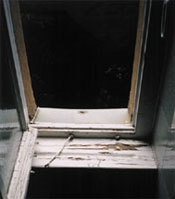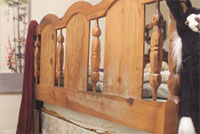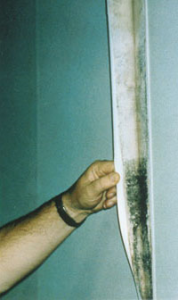1. Why is mold growing in my home?
Molds come in many colors; both white and black molds are shown here. Molds are part of the natural environment. Outdoors, molds play a part in nature by breaking down dead organic matter such as fallen leaves and dead trees, but indoors, mold growth should be avoided. Molds reproduce by means of tiny spores; the spores are invisible to the naked eye and float through outdoor and indoor air. Mold may begin growing indoors when mold spores land on surfaces that are wet. There are many types of mold, and none of them will grow without water or moisture.
2. Can mold cause health problems?
This [guidance] provides a brief overview; it does not describe all potential health effects related to mold exposure. For more detailed information consult a health professional. You may also wish to consult your state or local health department.
3. How do I get rid of mold?
4. Mold Cleanup
• If you choose to hire a contractor to do the cleanup, make sure the contractor has a Louisiana State Mold Remediation Contractor’s License. It’s against the law to do otherwise
• If you suspect that the air conditioning (HVAC) system may be contaminated with mold do not operate the HVAC system until it is professionally inspected by a mold expert.
• If the water and/or mold damage was caused by sewage or other contaminated water, then call in a professional who has experience cleaning and fixing buildings damaged by contaminated water.
5. Mold Cleanup Guidelines
The tips and techniques presented in this section will help you clean up your mold problem. Professional cleaners or remediators may use methods not covered in this publication. Please note that mold may cause staining and cosmetic damage. It may not be possible to clean an item so that its original appearance is restored.
• Fix plumbing leaks and other water problems as soon as possible. Dry all items completely.
• Scrub mold off hard surfaces with detergent and water, and dry completely.
• Absorbent or porous materials, such as ceiling tiles and carpet, may have to be thrown away if they become moldy. Mold can grow on or fill in the empty spaces and crevices of porous materials, so the mold may be difficult or impossible to remove completely.
• Avoid exposing yourself or others to mold
• Do not paint or caulk moldy surfaces. Clean up the mold and dry the surfaces before painting. Paint applied over moldy surfaces is likely to peel.
• If you are unsure about how to clean an item, or if the item is expensive or of sentimental value, you may wish to consult a mold remediation specialist. Specialists in furniture repair, restoration, painting, art restoration and conservation, carpet and rug cleaning, water damage, and fire or water restoration are commonly listed in phone books. Be sure to ask for and check references. Look for specialists who are licensed or affiliated with professional organizations.
6. What to Wear When Cleaning Moldy Areas
Avoid breathing in mold or mold spores. In order to limit your exposure to airborne mold, you may want to wear an N-95 respirator, available at many hardware stores and from companies that advertise on the Internet. (They cost about $12 to $25.) Some N-95 respirators resemble a paper dust mask with a nozzle on the front; others are made primarily of plastic or rubber and have removable cartridges that trap most of the mold spores from entering. In order to be effective, the respirator or mask must fit properly, so carefully follow the instructions supplied with the respirator. Please note that the Occupational Safety and Health Administration (OSHA) requires that respirators fit properly (fit testing) when used in an occupational setting; consult OSHA for more information (800-321-OSHA or www.osha.gov).
• Wear goggles. Goggles that do not have ventilation holes are recommended. Avoid getting mold or mold spores in your eyes.
7. How Do I Know When the Remediation or Cleanup is Finished?
• You should have completed mold removal. Visible mold and moldy odors should not be present. Please note that mold may cause staining and cosmetic damage.
• You should have revisited the site(s) shortly after cleanup and it should show no signs of water damage or mold growth.
• People should have been able to occupy or re-occupy the area without health complaints or physical symptoms.
• Ultimately, this is a judgment call; there is no easy answer. If you have concerns or questions consult a mold expert.
8. Moisture and Mold Prevention and Control Tips
• Clean and repair roof gutters regularly.
• Make sure the ground slopes away from the building foundation, so that water does not enter or collect around the foundation.
• Keep air conditioning drip pans clean and the drain lines unobstructed and flowing properly.
• Keep indoor humidity low. If possible, keep indoor humidity below 60 percent (ideally between 30 and 50 percent) relative humidity. Relative humidity can be measured with a moisture or humidity meter, a small, inexpensive ($10-$50) instrument available at many hardware stores.
• If you see condensation or moisture collecting on windows, walls or pipes ACT QUICKLY to dry the wet surface and reduce the moisture/water source. Condensation can be a sign of high humidity.
9. Actions that will help to reduce humidity
• Use air conditioners and/or de-humidifiers when needed.
• Run the bathroom vent fan when showering. Use exhaust fans or open windows whenever cooking, running the dishwasher or dishwashing, etc.
10. Actions that will help prevent condensation
• Increase ventilation or air movement by opening doors and/or windows, when practical. Use fans as needed.
• Cover cold surfaces, such as cold water pipes, with insulation.
• Increase air temperature.
11. Testing or Sampling for Mold
12. Hidden Mold
Suspicion of hidden mold
Locate and fix the source of the water promptly. You may suspect hidden mold if a building smells moldy, but you cannot see the source, or if you know there has been water damage and residents are reporting health problems. Mold may be hidden in places such as the back side of dry wall, wallpaper, or paneling, the top side of ceiling tiles, the underside of carpets and pads, etc. Other possible locations of hidden mold include areas inside walls around pipes (with leaking or condensing pipes), the surface of walls behind furniture (where condensation forms), inside ductwork, and in roof materials above ceiling tiles (due to roof leaks or insufficient insulation).
13. Investigating hidden mold problems
Investigating hidden mold problems may be difficult and will require caution when the investigation involves disturbing potential sites of mold growth. For example, removal of wallpaper can lead to a massive release of spores if there is mold growing on the underside of the paper. If you believe that you may have a hidden mold problem, consider hiring an experienced professional.
14. Cleanup and Biocides
Biocides are substances that can destroy living organisms. The use of a chemical or biocide that kills organisms such as mold (chlorine bleach, for example) is not recommended as a routine practice during mold cleanup. There may be instances, however, when professional judgment may indicate its use (for example, when immune-compromised individuals are present). In most cases, it is not possible or desirable to sterilize an area; a background level of mold spores will remain – these spores will not grow if the moisture problem has been resolved. If you choose to use disinfectants or biocides, always ventilate the area and exhaust the air to the outdoors. Never mix chlorine bleach solution with other cleaning solutions or detergents that contain ammonia because toxic fumes could be produced.
Please note: Dead mold may still cause allergic reactions in some people, so it is not enough to simply kill the mold, it must also be removed.










